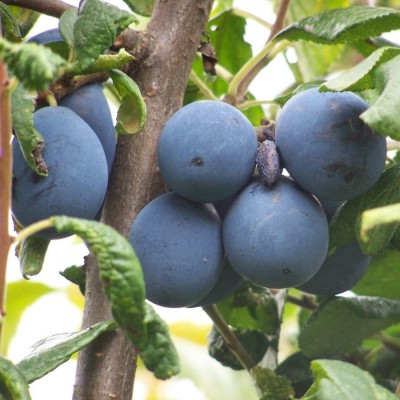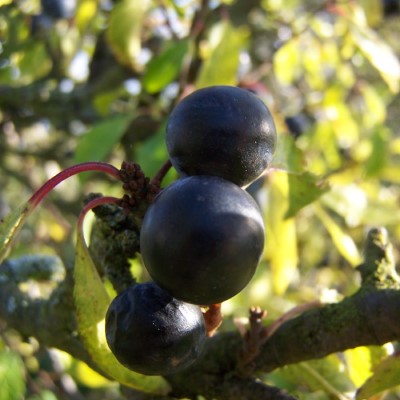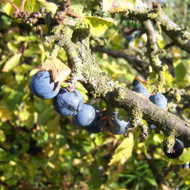Damsons, and their close relative, the little known bullace, are a godsend to the gardener who wants to grow fruit in an unfavourable location. Live in a cold area - no problem, these trees are bone hardy. Perhaps you live in the northwest, and the high rainfall causes scab and canker - again, grow damsons, they’ll thrive. In a world where every tv programme and gardening magazine tries to promote yet another exotic fruit that you can now grow in the U.K., perhaps it’s time to consider a fruit that has been grown here for at least two thousand years. If ‘right plant in the right place’ is the golden rule for successful gardening, then a damson tree could be the answer for those of us who struggle with less than ideal conditions.

Whereas plums are members of the Prunus domestica, damsons, bullaces (and cherry plums) are all part of the Prunus insititia category. The exact origins are not known - it’s believed that damsons originated in Damascus in Syria. However, stones of their very close relative the bullace (sometimes known as the white damson) have been found in Iron Age settlements in the U.K. as with many traditional orchard fruit, it was the Romans’ who cultivated the fruit more widely. The damson, or Damasen, is regularly mentioned by many herbalists in the 1600’s. ‘Damask Prunes’, dried damson fruit, were imported from France in large numbers. But it was in the cold damp climate of the Lake District that damsons found a perfect home.
Westmorland was an ancient county that now forms part of Cumbria. The Lyth and Winster valleys near Kendal saw the establishment of large damson orchards in the 1700’s. The fruit thrived where other trees would not, and damson growing became engrained in the local culture. In springtime, hoards would flock to the valley on ‘Damson Sunday’ to see the orchards and hedgerows in full blossom. In the autumn, the streets of Kendal would throng with carts selling the fruit. The majority would be sent to neighbouring Lancashire for jams and preserves. These orchards declined in the Twentieth Century as the cost of labour increased (as well as the shortage of sugar during the wars), but the past twenty years has seen an increase in interest in this fruit.
For the home gardener, the damson makes an ideal fruit tree. Hardy and reliable, they are more compact in growth than most other plums. They are all self-fertile, so no pollination worries. They are also much less susceptible to silverleaf disease, which is the main disease affecting plums. Being a stone fruit, they aren’t suitable for growing as cordons, but are very straightforward as small freestanding trees. On a vigorous rootstock such as Myrobalan B, they will make a tree some 6 metres tall at maturity, but on the semi-dwarfing St Julian A they will only reach 3 metres or so. Damsons and bullaces make a fantastic addition to a ‘fruiting hedge’ - mix with sloes and some cobnuts for a hedge that is not only wildlife friendly, but produces a bountiful harvest in autumn.

Being an acidic fruit, damsons will crop well in a semi-shaded spot, as they don’t require as much sun to form sugars in the fruit. Probably the only sites they will not like are those with thin, sandy soils, or extremely acidic soils. Otherwise, they are possibly the most amenable and easy to grow orchard tree.
As with all members of the plum family they blossom early, so they can be hit by spring frosts. If at all possible, fleece the tree if it is in flower and a cold night is forecast. Aphids can attack new foliage in the spring, causing it to blacken and curl, but won’t affect the crop or seriously weaken the tree. Use a soap solution (5ml of washing up liquid in 5 litres of water) and spray the undersides of the leaves to keep aphids under control.
The only serious disease to affect damsons is ‘pocket plum’. A fungal disease, it causes the young damsons to become distorted- elongated, bent and curiously flattened on one side. They also turn a light shade of yellow, which probably explains the other common name of ‘bent banana disease’. Don’t panic if this affects your tree - even in a bad year it will only affect less than half of the crop. This would be devastating for a commercial grower, but for the home gardener there will still be plenty of useable fruit. There is no chemical control, so good hygiene is key. Remove all diseased fruit as soon as you see them, and burn or destroy. If possible, winter wash in December (proprietary washes are available at all garden centres), as this should kill spores which overwinter on stems and branches.
Shropshire Prune. Once a common site in the orchards of Shropshire and Worcestershire, this is probably the most famous variety. Small dark blue-black fruit with a lovely flavour – rich, acidic, with a real damson ‘tang’.
Buy Damson 'Shropshire Prune'.
Merryweather. An excellent choice, with much larger fruit than other damsons. Introduced during the Victorian period when there was brief fashion for damsons, this was classed as a damson but is on the edge of being a small plum. The fruit is very slightly sweeter than Shropshire Prune, but with an outstanding depth of flavour.
Westmorland. The traditional damson of the Lake District. Probably originally a Shropshire Prune type, but has then hybridised with local bullaces and developed over centuries into a small dark blue fruit with probably the strongest damson flavour of all.
Farleigh. Found in Kent in the 19th Century, and still widely grown in the South-East. Excellent medium-sized fruit, very heavy to crop.
Uses:
Damson jam is without doubt one of the highlights of the winter store cupboard. The fruit are naturally high in pectin, so the preserve sets readily. Try experimenting by taking the skin off before jamming, the resulting fruit jelly is superb! Damsons have a deeper flavour and more acidity than plums, so damson chutney is excellent with cheeses and cold meats. You can also steep them in alcohol for a delicious alternative to sloe gin.

